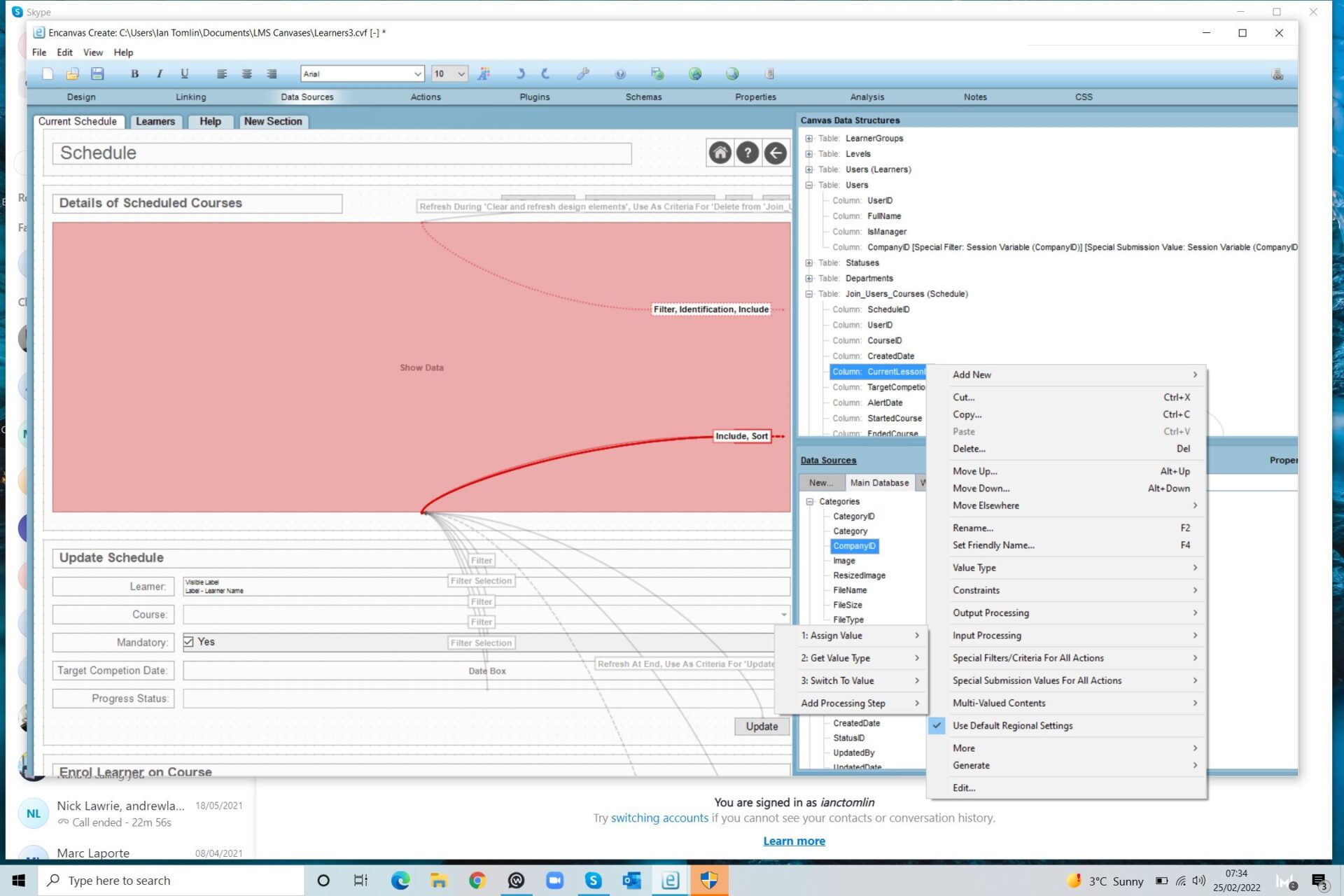EXPERIENCE ENCANVAS IN 60-MINUTES!
We're always happy to walk you through Encanvas no matter where you are in the world.

HyperAutomation is revolutionizing businesses, powered by new integration ware that makes it easier to glue AI, RPO, IOT and other tech advancements into incumbent business processes. HyperDrive is an example of the bleeding edge of this new enterprise tech. But how does it work and why is it so different to APIs and other data connectors?
Does your business have the ‘Amazonian’ capability to process every customer request directly from its web-shop or eCommerce site? If the answer is no, you wouldn’t be alone. A study by McKinsey of a leading high-street bank a decade ago found that almost 60% of processes still used hard-copy forms or required some level of human intervention. The fact is, the majority of business processes in most companies aren’t automated still today.
The role of a codeless iPaaS is to build a bridge between the data silos that span the enterprise to form up a single-version of the truth when it comes to the critical data landscapes executives need to see.
The quality of data that new app designers want to consume into their workflows remains the biggest single reason why projects derail. Try harvesting data from two or more apps and the challenges soon mount up.
For one thing, many systems still lack a codeless iPaaS to expose their data. Another challenge comes from the fact that businesses don’t always use software the way authors intended, and this can lead to data tables with many omissions. Incomplete data makes matching and organizing data hard to get right.
Even when you can (1) access data, and (2) find it to be of a reasonable quality, there remains the constant challenges of managing sessions (to prevent them from timing out), and knowing what to do with the data once you’ve got it uploaded.
For more than a decade, there have been a variety of Extract, Transform and Load (ETL) products available to app developers that will ‘take care’ of data uploads, transformation and republishing tasks.
But any app developer knows, consuming data often requires a lot of pre and post processing, much of which has to happen server-side on a relational database platform like SQL. All these scripts become a critical ingredient of deployed applications, the hidden heroes of new digital transformation projects. After a while, they become invisible to users and administrators, cogs in the data processing machine that few people can see, or know exist.
And that’s a problem. Because, when you want to adapt or change your app, there’s a good chance you will need to go back a re-bake these logic rules. If the developers that built these scripts move on, that can leave your project in a mess.
One of the biggest shortcomings of low-code and no-code enterprise app platforms has been their inability to think of everything.
Every now and then, requirements come along that demand more than the collection of app building blocks provided by the provider. For business-critical apps, very often, in-house development teams have over the years found themselves having to rebuild low-code deployments with hi-code solutions on enterprise systems like Oracle, Salesforce, or SAP.
Until now that is.
Encanvas, one of the leading providers of no-code enterprise applications platforms, has this year introduced a new technology called HyperDrive.
HyperDrive is an agnostic data plug-in technology that enables app developers to ingest code, script, third-party data sources, algorithms, and app plug-ins and DLLs into its no-code integrated development environment (IDE)—all done without scripting and coding. Which is clever, but what makes HyperDrive cleverer still is that the Encanvas team has added data pre-processing and post-processing into its HyperDrive tool.
Screenshot of Encanvas HyperDrive functionality. The feature is built into the Encanvas Integrated Development Environment


Author
Francesca is an independent writer and head of communications for technology brands. Armed with a passion for writing about innovative technologies that can transform business, she serves on the management team of Encanvas and has worked as a public relations adviser to the executive teams of various companies including Newton Day Ltd, TwoMinute Reads.com, NDMC Consulting, PrinSIX Technologies, and Answer Pay helping to rethink their marketing in order to tell their brand story. She can be reached via LinkedIn.
Now read:
At Encanvas we have a passion for low-code / no-code (we like to say codeless) software development. We’ve been leading innovation in the enterprise rapid applications development (low-code / no-code / data mashups) industry since 2002.
Our enterprise digital transformation platform is used to design, deploy and run custom apps by uniquely blending application (aPaaS), integration (iPaaS), Robotic Process Automation (RPA), and data mashup codeless software tools.
Encanvas brings agility and innovation to businesses. Used by data-driven organizations around the world, our platform evolves digitalization plans at the speed of light to maximize customer experience and minimize IT costs. Accelerate time to value of new applications as part of your digital transformation or data engineering program. Read the Encanvas Blog to learn more about what we do.

In its 2019 FutureScale outlook focusing on ‘Digital Supremacy’ IDC argued that operating as a software-driven “digital innovation factory” will be at the core of an enterprise’s ability to sustainably differentiate and compete in its own industry.
They suggested that, by 2025, nearly two thirds of enterprises will be prolific software producers with code deployed daily, over 90% of apps cloud native, 80% of code externally sourced, and 1.6 times more developers than today.
Watch any ad break on the TV and you will see 4 in 5 ads promoting apps or showing someone using a smart device. The world has gone mad for smart devices, AND APPS.
Why are so many companies becoming no-code software app factories?
A clue comes from McKinsey & Co. in its paper published in August 2020 titled, ‘The Next Normal—Digitizing at speed and scale’ where the management consulting and analyst firm suggests the recovery will be digital. They write, ‘The COVID-19 pandemic has heightened the need for companies to adopt digital business models—and only cloud platforms can provide the agility, scalability, and innovation required for this transition. Although there have been frustrations and false starts in the enterprise journey to the cloud, companies can dramatically accelerate their progress by focusing investments in it where they will provide the most business value and by building cloud-ready operating models.’
No business today can ignore the importance of transitioning incumbent slow-burn enterprise systems towards an agile, cloud-born, no-code software platforms that serve the information management demands of all stakeholders.
There are two major drivers of this move to no-code software. They are:

The pace of change in markets is unprecedented. It means laggards are no longer ‘just slow’ and missing out on opportunities. Without a place in the digital future, companies face extinction. According to research conducted by PWC in 2019 and 2021, around 1 in 5 surveyed companies (18%) implemented some form of Artificial Intelligence in 2019, but that dropped to 4% in 2020 when the pandemic gave businesses something else to think about. 2021 is likely to be the rebound year when businesses accelerate their digital plans to innovate their way out of the economic slowdown.
Frank Gens, Senior Vice President and Chief Analyst at IDC, argues, “As more than half the global economy turns digital by 2023, a new species of enterprise will be required to compete and thrive. IDC’s 2020 predictions show that enterprises will prepare for the digitized economy by accelerating investments in key technologies and new operating models to become hyperspeed, hyperscaled, and hyperconnected organizations.”
For many industries, customer aspirations have changed in the past year. Some businesses will be impacted by the raising demand for PPE and medical products. Others will have to deal with the consequences of more home working that reduces foot-fall in major commuter cities. Covid-19 brought the travel and tourism industry to its knees. Office space will drop in demand and value. And ANY business not already trading successfully online will need to get their act together in 2021. Those, however, are the top-line impacts. Consider too that consumers have reset their perspectives on what’s important. The pandemic has raised questions in the minds of buyers in the efficacy of a wasteful consumer society. Re-cycling, re-use, and business models framed around protecting the planet will trump behaviors that promote excess and extravagance.
Every business will face its own unique blend of challenges, and to counter them, the solution is to create a technology ecosystem that maximizes customer value and experience, while minimizing cost. Unfortunately, that doesn’t just come out of a box in a form executives can plug in—it needs to be crafted and deployed.

The modern no-code software app factory relies on a partnership between the IT team and ‘the business’ comprised of Line-of-Business (LoB) managers, execs and application stakeholders (which could be employees, contractors, customers, suppliers, industry partners, shareholders, etc.).
To herd the cats, you will also need a Project Manager to drive the ideation process. Additionally, a Business Analyst should be on hand to create the apps using a modern codeless Integrated Design Environment (Today, the app creation role has shifted away from the tech-stack deployment, scaling, backup and architectural considerations, and the operational governance responsibilities of IT).
Bringing these disparate interests together is the role of the FUSION TEAM. This is a transitional decision making ‘meeting of minds;’ where stakeholders come together to agree what should be built, how it should be deployed, and what people, process, technology and data considerations need to be thought about to make any app deployment a success.
The technology toolset will be a no-code application Platform-as-a-Service (aPaaS) of one form or another, deployed on a private cloud by the vendor. Expect to find in your tool-kit the Integrated Development Environment (IDE), together with data management and governance tools, heaps of data security, and the necessary data crunching and integration tools needed to harvest data from existing and third party repositories. It’s worth noting that almost no application exists as an island these days. Inevitably, your apps will need to harvest and serve up data to third party tools. With modern tech-stacks, this is normally achieved using codeless data connectors, so whilst still not a trivial task, it is surprisingly simpler than using APIs and third party integration platforms and tools.
How companies think about their enterprise stack has been slow to change. Company IT teams were educated to code and script. They have invested hours of their lives in learning the systems and tools your business uses today. Asking them to forget all that and adopt a new approach and set of skills is a big ask. Therefore, managing change is best done by bringing in some fresh thinking, either from a third party, or by hiring a Digital Officer familiar with the latest generation of cloud-born no-code software application ecosystems—such as Appian, ServiceNow, Encanvas, Outsystems, BettyBlocks or force.com.
Transitioning to become an APP FACTORY is a people, process, data, and technology transformation—and it’s never easy eating an entire pizza in one serving. For businesses that have yet to transition to FUSION TEAMS and NOCODE development, the likely starting point is to find a technology partner able to advise on how to progress.
The good news, is that no company has to be left behind. Every opportunity exists to get on the band-wagon and to build up your capability to develop a digital ecosystem to build agility into your tech-stack and orchestrate your business model one app at a time.
Looking for enterprise-grade no-code software for YOUR app factory? To experience ENCANVAS for yourself, book a test drive.

Author
Francesca is an independent writer and head of communications for technology brands. Armed with a passion for writing about innovative technologies that can transform business, she serves on the management team of Encanvas and has worked as a public relations adviser to the executive teams of various companies including Newton Day Ltd, TwoMinute Reads.com, NDMC Consulting, PrinSIX Technologies, and Answer Pay helping to rethink their marketing in order to tell their brand story. She can be reached via LinkedIn.
Now read:

OXFORD-UK, August 10, 2020 – Encanvas today unveiled the latest version of its Enterprise-Grade Codeless Enterprise Applications Platform. Encanvas/4 makes it possible for the ideas people of an enterprise to create machine-to-machine and human-to-machine apps in workshops using Agile Codeless methods.
The global pandemic has raised demands on businesses to move to online sales and marketing. Business leaders are pressured to closely integrate their websites to back-office systems and orchestrate business models, one app at a time, to maximize customer experience while minimizing operating costs through hyper-automation.
This drive towards use of digital technologies to bring differentiating value to customers, means companies have become app innovation factories. This demand is fuelled a growing Rapid Applications Development tech industry and Low-Code app development solutions estimated to reach 1$46.4 billion by 2026.
Solutions for Rapid Applications Development in the market today target two separate audiences; so-called Citizen Developers that want to create apps themselves but lack coding skills, and IT Professionals engaged in applications development but seeking faster ways to deliver outcomes.
Encanvas/4 has been expressly designed to equip fast growing businesses and large enterprises with a secure private cloud app ecosystem to design, deploy and run as many apps as they need and change them as often as they like. Additionally, it provides the means to integrate existing data repositories and websites with core business systems to create a data driven business able to experience their customer landscape from the first contact to the latest transaction.
Encanvas claims its No-Code approach uniquely breaks down the divide between IT and the business by equipping Business Analysts with the means to support the end-to-end app ideation process, while further empowering IT teams to maintain data security, app deployment, performance, scaling and governance roles. Using Encanvas, businesses can displace self-authored shadow systems and spreadsheets, migrate human-in-the-loop processes to full automation, and simplify their app architectures and data models to cut legacy burdens while increasing data asset value.
With many firms considering or already engaged in digital transformations, Encanvas supplies the app ecosystem and integration-ware to support Hyper-Automation. It promises the fastest time to value while bringing together e-forms, robotic automation (RPA), artificial intelligence (AI), data science, and workflow in one platform.
Encanvas produces improved customer experiences and digital transformations one enterprise application at a time, delivered up to 10 times faster than Low-Code.
Originally launched in 2003, new features in the version 4.0 platform include:
• Live-Wireframing – Technology to design, create and publish ready-to-deploy prototypes without coding or scripting in workshops.
• AppFabric – Technology to manage the formation of private cloud app ecosystems, separating the ideation role duties of Business Analysts from the deep technical roles fulfilled by IT Professionals.
• Hyper-Drive – A Universal Data Plug that means third party code, script, apps or data sources can be fully embedded into Encanvas’s codeless ‘building block’ app ecosystem.
• Web iFrame Integration – Giving app designers an elegant way to integrate Encanvas forms and apps into their existing websites and app portals.
Encanvas/4 is generally available in October 2020.
Encanvas is an enterprise software company and the developer of the Encanvas Codeless Applications Platform. The Encanvas/4 codeless app ecosystem supports applications design, deployment and operation without coding or scripting. It produces enterprise-grade apps and helps change management teams to evolve business IT at the speed of light to maximize customer experience and minimize costs. Build the apps you need and change them as often as you like. Many of the world’s largest organizations have used Encanvas applications to automate, transform and grow. For more information, visit www.encanvas.com.
Source:
1 – Report by KBV Research on the Global Low-Code Development Platform Market.
PRESS AND MEDIA CONTACT DETAILS:
Encanvas
Dove Cottage Offices, Abingdon Road, Marsham, Oxfordshire OX13 6NU, United KingdomTel: 02 3983 7001
info@encanvas.com
Media and Press Contacts:Newton Day Ltd
3rd Floor, 86-90 Paul Street, London, EC4a 2NE
Francesca Manleyfrancesca.manley@newtonday.uk